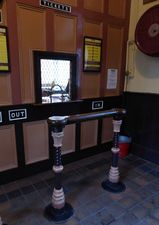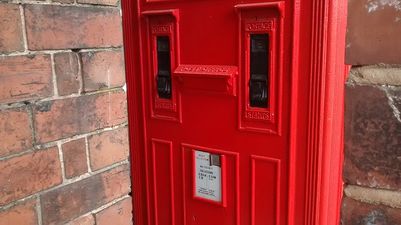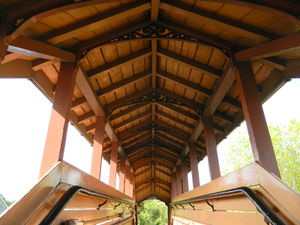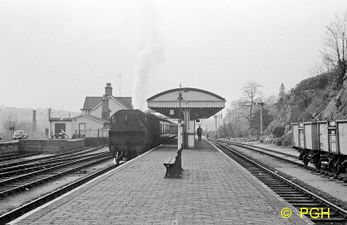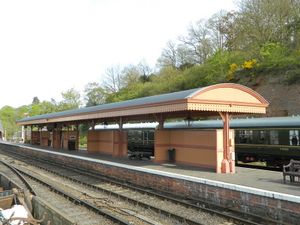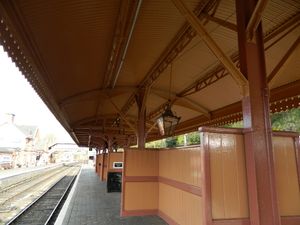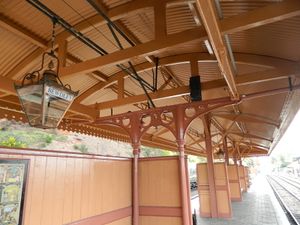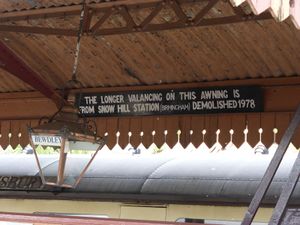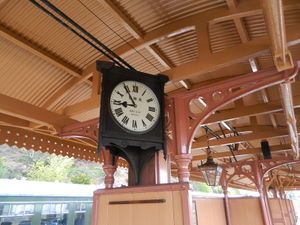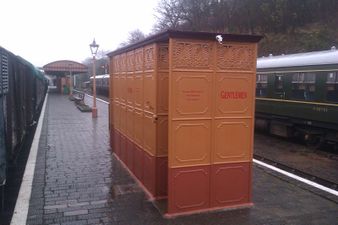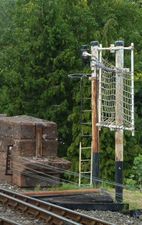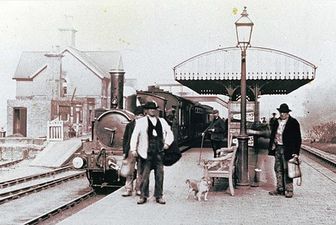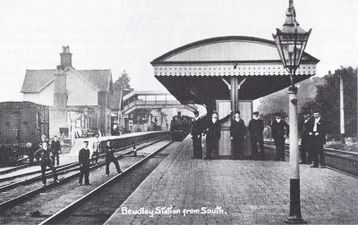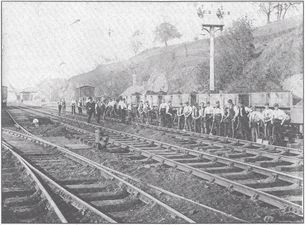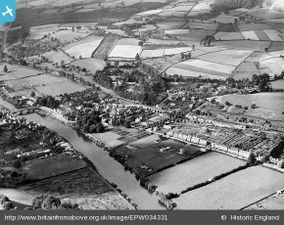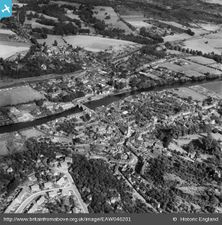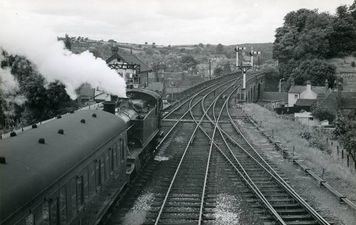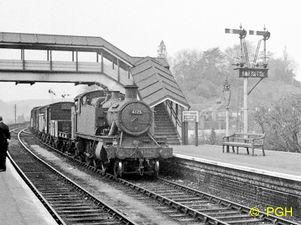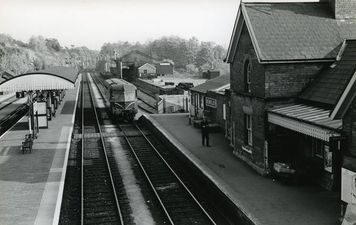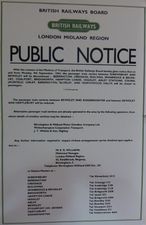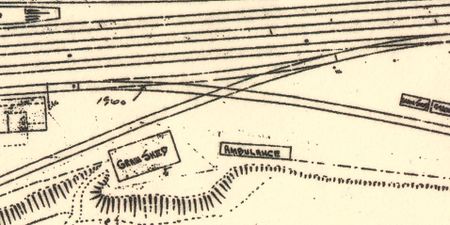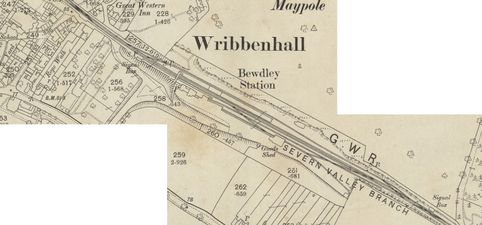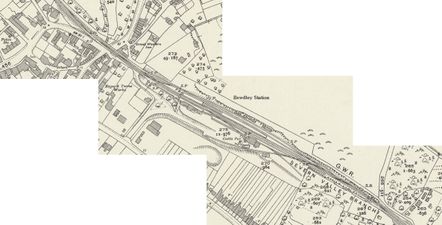Eardington and Bewdley: Difference between pages
→The platform: CT funding |
additional info and history |
||
| Line 1: | Line 1: | ||
[[File: |
[[File:Bewdley station - general view - geograph.org.uk - 1255902.jpg|thumb|300px|right|Bewdley station]] |
||
[[File:Southern approach to Bewdley.jpg|thumb|300px|right|Southern approach to Bewdley]] |
|||
{| class="wikitable" |
{| class="wikitable" |
||
|+Next stations |
|+Next stations |
||
| Line 6: | Line 6: | ||
! Up (towards [[Kidderminster]]) !! Down (towards [[Bridgnorth]]) |
! Up (towards [[Kidderminster]]) !! Down (towards [[Bridgnorth]]) |
||
|- |
|- |
||
| [[ |
| [[Kidderminster]] (3½ miles) || [[Arley]] (3¾ miles)<br>via [[Northwood Halt]] |
||
|- |
|- |
||
|} |
|} |
||
Eardington is a disused station, situated on [[Eardington Bank]] and located mid-way between [[Bridgnorth]] and [[Hampton Loade]] at milepost 147¾. Although the station does not currently feature in daily operations a dedicated 'Friends of Eardington Station' team lead by Steve Downs looks after and maintains this wayside gem. |
|||
{| class="wikitable" |
|||
==Eardington history before preservation== |
|||
|+Next stations pre-closure |
|||
|- |
|||
! Towards [[Hartlebury]] !! Towards [[Kidderminster]] !! Towards [[Shrewsbury]] !! Towards [[Wyre_Forest_Line#Tenbury_Wells | Tenbury Wells]] |
|||
|- |
|||
| [[Stourport]] (2½ miles) )<br>via [[Burlish Halt]] (from 1930) || [[Kidderminster]] (3¾ miles)<br>via [[Rifle Range Halt]] (1905-1920)<br>and [[Foley Park Halt]] (1905-1970) || [[Arley]] (3¾ miles)<br>via [[Northwood Halt]] (from 1935) || [[Wyre_Forest_Line#Wyre_Forest | Wyre Forest]] |
|||
|- |
|||
|} |
|||
*1864: A siding connection to Lower Forge was proposed but never built. Upper Forge and Lower Forge were two local ironworks, located respectively west and east of the line and joined by a 750 yard long navigable canal tunnel.<ref name = "Marshall103" />. |
|||
==The station== |
|||
*1868: Eardington Station opened on 1 June 1868, some six years after the opening of the Severn Valley Railway<ref name = SVR Guide”>SVR Souvenir Guide, Ninth Edition</ref>. |
|||
Bewdley station in Worcestershire has three platforms and was formerly the junction for both the [[Wyre Forest Line | Wyre Forest]] and [[Stourport Branch | Stourport]] lines, both of which are now used as sidings. |
|||
*1893: The station platform was extended<ref name = "Marshall103" />. |
|||
*1899: The ironworks closed<ref name ="Marshall103" />. |
|||
The station is controlled by two signal boxes, [[Bewdley South signal box | Bewdley South]] and [[Bewdley North signal box | Bewdley North]]. The section through platforms 1 and 2 is the only [[Double track | double track]] section of the present SVR. This is worked under [[Absolute Block]] regulations. |
|||
*1931: The station lost its station master, coming under the control of [[Highley]].<ref name=SVRNews201>SVR News 201 'Eardington News' (Steve Downs)</ref> |
|||
*1949: BR reduced the station to unstaffed status after 1 April 1949.<ref name = SVR Guide” />. |
|||
[[Bewdley Down Yard]] is home to the [[Bewdley Carriage & Wagon Department | Carriage and Wagon department]] which supplements the [[Carriage Repair Works | Carriage Repair Department]] at Kidderminster and maintains the fleet of goods wagons. A considerable amount of [[:Category:Rolling stock in Bewdley Down Yard|rolling stock is stabled there]] including [[Rolling stock currently under restoration|rolling stock under restoration]]. Public access to the yard is available during the annual [[Open House Weekend]] (and was formerly available during the [[Peep Behind the Scenes]] event). |
|||
*1952: The first noted instance of the station being referred to as "Eardington Halt" in a BR timetable.<ref name=SVRNews201/> |
|||
*1959: The goods loop was reduced to a siding, accessed from the south end only<ref name = SVR Guide” />. The station was still called "Eardington" in the [[Timetable: Severn Valley and Tenbury Lines 1959|1959 BR Working Timetable]]. |
|||
[[Bewdley MPD]] is home to the [[Class 108 DMU]]. Other operational locomotives are also stabled at Bewdley, running light engine to Kidderminster at the start and end of each day as required. On certain Gala days a DMU shuttle service is operated between [[Stourport Triangle]], Bewdley and the short remaining length of former [[Tenbury Branch]] track immediately north of Bewdley to recreate the feel of a country junction station. |
|||
*1963: The station closed when passenger traffic ceased on 9 September 1963<ref name = SVR Guide” />. |
|||
*1964: The former goods loop siding was completely removed<ref name = SVR Guide” />. |
|||
Bewdley Platform 1 is home to the Volunteer Liaison Office. |
|||
==Legal Charge== |
|||
On 8 August 1988 [[Severn Valley Railway (Holdings) PLC]] gave a Legal Charge in favour of the County Council of Hereford & Worcester in respect of "All that land at Bewdley containing six point seven acres or thereabouts together with the buildings erected thereon." The charge was given as security against "All monies due or to become due from the company to the chargee under the terms of agreement dated 10.5.88." {{As of|2022}} its status is shown as 'Outstanding'.<ref>[https://find-and-update.company-information.service.gov.uk/company/01046274/charges] (Retrieved 13 December 2020)</ref> The Council itself was abolished in 1998 and reverted to the two separate historic counties of Herefordshire and Worcestershire. |
|||
==Facilities== |
|||
Bewdley has limited public pay and display parking. Three [[List of shops | sales coaches]] run by support groups are adjacent to the car park. |
|||
In March 2018 the buffet adjacent to Platform 1 (but not the more recent toilet block and kitchen) was closed pending demolition of the buffet building, which took place from 16-19 July. [[BR 4593 Tourist Standard Open]] was moved to the dock in front of the buffet to be used as seating for staff and the public, with table service provided from the kitchen. In January 2020 a prefabricated timber buffet building was installed on the concrete plinth of the old buffet building, and 4593 was removed. |
|||
The main passenger access to island platforms 2 and 3 is via the [[Bewdley Station Footbridge|footbridge]], but the only access route for those with restricted mobility is via a barrow crossing at the opposite end of the platform, accessed through the [[Bewdley Down Yard]]. A 2021/22 project funded primarily by the [[Severn Valley Railway Charitable Trust Ltd|Charitable Trust]] to improve access includes a reinforced concrete path between the gates protecting the rail crossing and the yard gates adjoining the car park, with a branch to the existing disabled toilets; removal of the obtrusive GWR water tower on the island platform; improvements to the crossing itself; and appropriate signage<ref>[https://www.svrlive.com/bloct21 Branch Lines, October 2021]</ref>. In October 2022 the SVR announced:'' "it is hoped that external funding can also support the creation of a disabled toilet facility on the station platform. This will hugely improve facilities for our less-abled visitors"''<ref>[https://www.svrlive.com/bloct22 Branch Lines October 2022]</ref>. |
|||
== Points of interest == |
|||
====Booking hall==== |
|||
The booking hall had been ‘modernised’ by BR with tall ticket windows and plywood facing. The plywood was removed in winter 1980-81 to reveal the original GWR panelling. At the same time the smaller windows were reinstated and fitted with brass wired grids acquired from the old Birmingham Snow Hill station. The balustrades in front of the windows also came from Snow Hill<ref>SVR News 59</ref>. |
|||
<gallery mode=packed heights=150px style="text-align:left"> |
|||
File: Bewdley_Booking_Office_20151114.jpg | Ticket window and balustrade |
|||
</gallery> |
|||
====Phone box==== |
|||
The phone box outside the station is an example of the K4 type, introduced in 1930. The K4, nicknamed the Vermillion Giant, was a combined telephone and post box. Only 50 were ever produced.<ref>[http://www.redphonebox.info/galleryK4.html RedPhoneBox.info]</ref> |
|||
The box is Grade II listed by Historic England and described as "Intact but not on original site".<ref> [https://historicengland.org.uk/listing/the-list/list-entry/1100700 Historic England listing entry for the phone box] </ref> It arrived on the SVR in winter 1981-82 on permanent loan from the Ironbridge Gorge Museum Trust<ref>SVR News 62</ref> and was originally situated on Platform 1.<ref>SVR News 66</ref>. |
|||
<gallery mode=packed heights=150px style="text-align:left"> |
|||
File:Phone box at Bewdley Station - geograph.org.uk - 1454715.jpg | Phone box at Bewdley |
|||
File:Phone box rear.jpg | Rear view of phone box |
|||
</gallery> |
|||
==== Footbridge ==== |
|||
A covered wooden [[Bewdley Station Footbridge|footbridge]] at the northern end of the station allows access between Platform 1 and Platforms 2&3. It is [[List of infrastructure|numbered bridge 10]]. |
|||
<gallery mode=packed heights=150px style="text-align:left"> |
|||
File:Bewdley station - north end - geograph.org.uk - 899053.jpg|Bewdley station footbridge |
|||
File:Bewdley footbridge interior.JPG|Bewdley footbridge interior |
|||
</gallery> |
|||
==== Water towers ==== |
|||
Two water towers at the southern end of Platforms 2&3 and in the MPD area allow watering of locomotives. The tower on the island platform is of GWR origin and was recovered from Stow Heath yard, Bilston in 1969. The tower next to the MPD is of LNWR origin and was retrieved from Hadley, near Wellington, in October 1972<ref>SVR News 29</ref>. Both columns were installed during the winter of 1973-74<ref>SVR News 31</ref>. Unlike at Bridgnorth and Kidderminster, the water supply at Bewdley is not specially treated, and so the columns are only used on rare occasions such as galas. |
|||
In October 2020 the [[Charitable Trust]] announced a project to improve wheelchair access to the island platform via the barrow crossing next to the MPD. The announcement noted that "''The SVR also aim to remove the water tower at the base of the platform ramp as it is causing an obstruction and puddles on the access route. This water tower is not an original feature, but was a later addition, installed during the preservation era, that is no longer essential to operations. This will be relocated to [[Highley|Highley Station]]''."<ref>[https://www.svrtrust.org.uk/index.php?page=News Charitable Trust 2020 News page]</ref> |
|||
<gallery mode=packed heights=150px style="text-align:left"> |
|||
File:Bewdley railway station MMB 04 6024.jpg|Water towers at Bewdley station |
|||
File:Bewdley water towers.jpg|Water towers as viewed from the platform |
|||
</gallery> |
|||
==== Island platform canopy ==== |
|||
Platforms 2 and 3 share a canopy, built in 1878, giving passengers protection from the weather. The canopy, featuring timber frames on cast iron pillars was extended around 1900 with the new section supported on steel frames. |
|||
<gallery mode=packed heights=150px style="text-align:left"> |
|||
File:Bewdley Station - geograph.org.uk - 1477635.jpg|Bewdley station from the footbridge, showing the island canopy |
|||
File:PGH Bewdley.jpg|An up train in platform 2 in April 1962 (PG Hindley) |
|||
File:Bewdley canopy 3.JPG | Bewdley island platform canopy shortly after completion of refurbishment in April 2016 |
|||
File:Bewdley canopy 1.JPG | Underside view of the canopy showing the two different methods of construction |
|||
File:Bewdley canopy 2.JPG | Underside view of the canopy showing the two different methods of construction |
|||
File: Bewdley_Canopy_20150528.jpg | The canopy was refurbished using materials from the old Snow Hill station. |
|||
</gallery> |
|||
==== Platform clock ==== |
|||
The double-faced clock under the island platform canopy was built for the GWR by Kays of Worcester in the late 19th or early 20th century. It was used at nearby Stourbridge Junction until 1977 when, no longer required by BR, it was acquired by staff from [[Arley]] station. It worked until 1998, but then underwent a year-long overhaul, being re-commissioned on 10 April 1999<ref>SVR News 130</ref>. |
|||
<gallery mode=packed heights=150px style="text-align:left"> |
|||
File:Bewdley station clock.jpg|Bewdley station clock |
|||
</gallery> |
|||
==== Gent's urinal ==== |
|||
An open roofed cast iron gentlemen's urinal is located on Platforms 2 and 3 on the site of the original urinal which was built in 1896. The replacement was relocated from Melrose in Scotland by SVR volunteers and formally opened in [[Severn Valley Railway Timeline 1970-1979#1977 | September 1977]]. See 'Links' below for two copyrighted images of the urinal at Melrose. |
|||
<gallery mode=packed heights=150px style="text-align:left"> |
|||
File:Bewdley gents urinal.jpg|Bewdley gents urinal |
|||
File:Bewdley gents urinal detail.jpg|Bewdley gents urinal detail |
|||
</gallery> |
|||
==== Portable water tank ==== |
|||
A portable water tank with hand powered pump was used for the refilling of carriage water tanks. |
|||
<gallery mode=packed heights=150px style="text-align:left"> |
|||
File:Water Carrier - geograph.org.uk - 1492157.jpg|Portable water tank |
|||
</gallery> |
|||
====Token catcher==== |
|||
The token catcher opposite Bewdley North signal box was originally located opposite Bewdley South signal box, where it could be used by locomotives on the former [[Stourport Branch]]. It was moved to its present location during the 1974-75 close season<ref>SVR News 36</ref>. It is not currently in use, tokens instead being exchanged by hand. |
|||
<gallery mode=packed heights=150px style="text-align:left"> |
|||
File: Token_Catcher_20110814.jpg | Token catcher opposite Bewdley North signal box |
|||
</gallery> |
|||
== Bewdley history before preservation == |
|||
[[File:Bewdley railway station 1795793 c24b1cba.jpg|thumb|300px|right|Bewdley station in 1963 (Geograph)]] |
|||
*1862 Bewdley has a population of 2900<ref>[[Bibliography | Handbook to the Severn Valley Railway, J. Randall, 1863]]</ref> (Population; 10869 in 2001)<ref>[http://www.wyreforestdc.gov.uk/things-to-see-do-and-visit/tourism-and-travel/guide-to-bewdley.aspx 2001 census]</ref> |
|||
*1862: When the Severn Valley Line opened, Bewdley was a crossing point and was deemed a principal station, being provided with a goods shed and goods yard. Construction of the [[Wyre Forest Line | Tenbury and Bewdley Railway]] and the [[Kidderminster Loop Line]] had already been authorised, and the station was always planned to be a junction. |
|||
*1864: The Tenbury and Bewdley Railway opened on 13 August. Around that time turntable was moved from Bewdley and re-erected in the goods yard at [[Wyre Forest Line#Tenbury_Wells|Tenbury]] |
|||
*1877: In preparation for the delayed opening of the Kidderminster Loop, authorisation was given to enlarge the island platform and provide a shelter and footbridge. New Bewdley North and Bewdley South signal boxes were also built. |
|||
*1878: The Kidderminster Loop opened on 1 June. |
|||
*1900: Authorisation was given for additional siding space including the [[Rock Siding]] at the back of Platform 3 and the siding along the far side of the yard. |
|||
*1922: [[SVR staff in 1922#Severn Valley Railway (Kidderminster to Bridgnorth)|GWR staff records]] show the station had a staff of 19. |
|||
*1962: Passenger services to Tenbury ceased on 31 July<ref>[[Bibliography#Books|Beddoes and Smith ((1995)]] p. 193.</ref> (services beyond Tenbury to Woofferton had ended a year earlier). |
|||
*1963: Passenger services towards Shrewsbury ceased on 9 September, with through freight services ending at the end of November. The Public Notice announcing closure of the line can be seen behind the ‘Platform 1’ sign in the photograph to the right (a copy of the closure notice is on display in [[The Engine House]]). |
|||
*1964: Goods services ended on the Tenbury Branch and the line was closed. |
|||
*1965: The goods yard closed on 1 February. |
|||
*1969: All goods traffic north of Bewdley ceased with the closure of [[Alveley Sidings | Alveley Colliery]]. This enabled the SVR Society to rent the former goods-shed and yard (even though they had not yet opened the first section of the railway between Bridgnorth and Hampton Loade by that time). This space was used for restoration of locomotives and rolling stock, 4566 and 1501 being among the earliest residents. |
|||
*1970: Passenger services to Kidderminster and Hartlebury ended on 5 January, ending the pre-preservation use of Bewdley Station. |
|||
A 1935 GWR plan of Bewdley shows an "Ambulance" in the Down Yard. This was a grounded M&SWJR coach body used as a First Aid training centre. |
|||
<gallery mode=packed heights=150px style="text-align:left"> |
|||
File:Bewdley1898.jpg|Bewdley Station in 1898 |
|||
File:Bewdley_1910.jpg|Bewdley Station circa 1910 |
|||
File:Bewdley PW.jpg|Permanent Way gang at Bewdley |
|||
File:Bewdley Britain From Above 1930.jpg|Aerial view of Bewdley in 1930 |
|||
File:Bewdley Britain From Above 1952.jpg|Aerial view of Bewdley in 1952 |
|||
File:PrairieBewdleyNorth-1959-10-07.jpg|A train waits to depart Northbound from Platform 1 in October 1959 ([[Sellick Collection]]) |
|||
File:PGH BewdleyGoods.jpg|An up goods passes Bewdley in April 1962 (PG Hindley) |
|||
File:Bewdley-Railcar-1962-10-06.jpg|An ex-GWR DMU arrives at Bewdley in October 1962 ([[Sellick Collection]]) |
|||
File:Closure_Notice.jpg | Closure notice |
|||
File:Bewdley ambulance.jpg | Plan showing ambulance in Down Yard |
|||
</gallery> |
|||
{| class="wikitable |
|||
|+ Early Station Masters at Bewdley prior to 1939 |
|||
|- |
|||
!Name!!Born !! data-sort-type="date" | From !! data-sort-type="date" | To !! Comments |
|||
|- |
|||
|Thomas Appleton||26 April 1826 Newton-Le-Willows, Lancashire|| data-sort-value="1/8/1863" | August 1863||data-sort-value="31/1/1897" | 31 January 1897||Joined West Midland Railway October 1854. Retired 1897. Died 17 April 1906, Worcester |
|||
|- |
|||
|George Smith||14 January 1867 Shipton Oxfordshire||data-sort-value="1/9/1898" | September 1898||data-sort-value="1/12/1909" | 1 December 1909||Started work 6 November 1882. Station Master at Bridgnorth circa 1917 |
|||
|- |
|||
|Frederick William Augustus Hallett||12 August 1868 Batheaston, Somerset||data-sort-value="1/12/1910" | 1 December 1910||data-sort-value="23/7/1914" | 23 July 1914||Started work 9 January 1882. Died in 1914 in nursing home at Proud Cross, Kidderminster |
|||
|- |
|||
|Ernest James Neate Carter||21 September 1879 Slough, Buckinghamshire||data-sort-value="1/1/1914" | 1914?|| data-sort-value="1/1/1926" | 1926?||Started work 10 September 1894. Died 7 November 1959 |
|||
|- |
|||
|George William Lane||31 May 1872 Hartlebury, Worcestershire||data-sort-value="1/1/1924" | After 1924|| ||Started work 31 May 1872. Employed at Bewdley as a passenger clerk between December 1896 and October 1899. Died 9 January 1961 |
|||
|- |
|||
|} |
|||
{| class="wikitable" |
{| class="wikitable" |
||
|+ [[ |
|+ |+ [[Traffic statistics in commercial service]] for Bewdley (including Northwood Halt), selected years 1903 to 1952 |
||
|- |
|- |
||
! !! colspan="3" | Passenger Traffic !! colspan="2" | Freight Traffic !! |
! !! colspan="3" | Passenger Traffic !! colspan="2" | Freight Traffic !! |
||
| Line 32: | Line 168: | ||
! Year !! Tickets issued !! Parcels despatched !! Revenue (£) !! Tons received & despatched !! Revenue (£) !! Total revenue (£) |
! Year !! Tickets issued !! Parcels despatched !! Revenue (£) !! Tons received & despatched !! Revenue (£) !! Total revenue (£) |
||
|- |
|- |
||
|1903||style="text-align:right"| |
|1903||style="text-align:right"|63,131||style="text-align:right"|15,577||style="text-align:right"|4,296 |
||
|style="text-align:right"|16,588||style="text-align:right"|5,076||style="text-align:right"|9,372 |
|||
|- |
|- |
||
|1913||style="text-align:right"| |
|1913||style="text-align:right"|82,475||style="text-align:right"|19,845||style="text-align:right"|4,702 |
||
|style="text-align:right"|17,020||style="text-align:right"|4,074||style="text-align:right"|8,776 |
|||
|- |
|- |
||
|1923||style="text-align:right"| |
|1923||style="text-align:right"|92,463||style="text-align:right"|16,783||style="text-align:right"|7,584 |
||
|style="text-align:right"|20,171||style="text-align:right"|7,553||style="text-align:right"|15,137 |
|||
|- |
|- |
||
| |
|1929||style="text-align:right"|92,479||style="text-align:right"|17,812||style="text-align:right"|6,202 |
||
|style="text-align:right"|20,201||style="text-align:right"|8,875||style="text-align:right"|15,077 |
|||
|- |
|- |
||
| |
|1930||style="text-align:right"|88,763||style="text-align:right"|14,840||style="text-align:right"|5,251 |
||
|style="text-align:right"|19,323||style="text-align:right"|7,812||style="text-align:right"|13,063 |
|||
|- |
|||
|1931||style="text-align:right"|69,627||style="text-align:right"|14,706||style="text-align:right"|4,922 |
|||
|style="text-align:right"|20,599||style="text-align:right"|9,227||style="text-align:right"|14,149 |
|||
|- |
|||
|1932||style="text-align:right"|56,206||style="text-align:right"|13,689||style="text-align:right"|4,042 |
|||
|style="text-align:right"|16,907||style="text-align:right"|7,180||style="text-align:right"|11,222 |
|||
|- |
|||
|1933||style="text-align:right"|56,012||style="text-align:right"|15,578||style="text-align:right"|4,007 |
|||
|style="text-align:right"|15,158||style="text-align:right"|6,802||style="text-align:right"|10,809 |
|||
|- |
|||
|1934||style="text-align:right"|55,051||style="text-align:right"|15,834||style="text-align:right"|4,061 |
|||
|style="text-align:right"|14,797||style="text-align:right"|6,679||style="text-align:right"|10,740 |
|||
|- |
|||
|1935||style="text-align:right"|61,135||style="text-align:right"|16,093||style="text-align:right"|3,988 |
|||
|style="text-align:right"|13,668||style="text-align:right"|5,920||style="text-align:right"|9,908 |
|||
|- |
|||
|1936||style="text-align:right"|63,262||style="text-align:right"|16,300||style="text-align:right"|3,896 |
|||
|style="text-align:right"|14,457||style="text-align:right"|6,931||style="text-align:right"|10,827 |
|||
|- |
|||
|1937||style="text-align:right"|66,925||style="text-align:right"|16,001||style="text-align:right"|4,164 |
|||
|style="text-align:right"|13,357||style="text-align:right"|5,627||style="text-align:right"|9,701 |
|||
|- |
|||
|1938||style="text-align:right"|60,251||style="text-align:right"|14,120||style="text-align:right"|3,748 |
|||
|style="text-align:right"|10,874||style="text-align:right"|3,833||style="text-align:right"|7,581 |
|||
|- |
|||
|1942||style="text-align:right"|93,092||style="text-align:right"|X||style="text-align:right"|7,325||style="text-align:right"|17,227||style="text-align:right"|X||style="text-align:right"|X |
|||
|- |
|||
|1947||style="text-align:right"|72,637||style="text-align:right"|12,251||style="text-align:right"|6,479||style="text-align:right"|13,376||style="text-align:right"|X||style="text-align:right"|X |
|||
|- |
|||
|1952||style="text-align:right"|64,647||style="text-align:right"|9,138||style="text-align:right"|5,328||style="text-align:right"|28,528||style="text-align:right"|X||style="text-align:right"|X |
|||
|- |
|- |
||
|} |
|} |
||
X: Data not recorded |
|||
==Historic maps of Bewdley Station== |
|||
==Eardington in preservation== |
|||
In the earliest days of the SVR, when Bridgnorth and Hampton Loade formed the limit of operations, Eardington was used as an intermediate stopping point and watering place and was sometimes referred to as Eardington Halt. |
|||
* GWR plan of Bewdley station with the original lines in blue and the Rock Siding and alterations to the Down Yard as later amendments in red |
|||
During the period of [[Sir Gerald Nabarro]]'s chairmanship it was closed in connection with the possible rebuilding of Eardington as the northern terminus on the line. It later re-opened in March 1981, but last appeared in the timetable as a request stop in 1982,<ref name = "Marshall103">The Severn Valley Railway, John Marshall (1989) p103</ref> after which it was removed from regular use due to the steep gradient, short platform, and low passenger numbers<ref>[http://en.wikipedia.org/wiki/Eardington_Halt_railway_station Wikipedia]</ref>. |
|||
* 1884 map showing scissors crossovers at both ends of the station and the short platform canopy |
|||
* 1903 map showing facing and trailing crossovers, the Rock siding and an additional siding in the goods yard |
|||
* 1927 map showing the longer platform canopy and changes to the southern access to the Back Road and Rock Siding |
|||
* 1938 map showing little had changed since 1927 |
|||
* 1964 map showing showing changes to the southern access to the Back Road and the goods yard |
|||
* 1905 GWR schematic plan of Bewdley giving siding capacities and other details. |
|||
<gallery mode=packed heights=150px style="text-align:left"> |
|||
It has since been cosmetically restored by the Friends and is occasionally opened to visitors on gala days. On 2-3 June 2018 it staged "'''Eardington 150'''" to mark its 150th birthday. The station was open to the public on both days with various special attractions (trains did not stop). The event coincided with the SVR's Goods Gala.<ref>[https://www.shropshirestar.com/entertainment/attractions/2018/06/04/restored-shropshire-railway-station-celebrates-150-years---with-video-and-pictures/ SVR's PR on Shropshire Live website 4 June 2018] (Retrieved 24 June 2018)</ref> |
|||
File:GWRplanBewdley.jpg |
|||
File:Bewdley1884map.jpg | 1884 |
|||
===The platform=== |
|||
File:Bewdley1903map.jpg | 1903 |
|||
The southern end of the platform was cut back after it collapsed. The Friends held a fundraising appeal in 2014 to replace the missing part;<ref>SVRA Working Members Newsletter November 2014</ref> it was reported on 27 October 2016 that sufficient funds had been raised to purchase the required replacement GWR bricks.<ref>[https://twitter.com/Eardingtonstn/status/791730973977219072 Eardington Station Twitter Feed], retrieved 1 November 2016</ref> |
|||
File:Bewdley1927map.jpg | 1927 |
|||
File:Bewdley1938map.jpg | 1938 |
|||
A project funded by the Friends, [[Severn Valley Railway Charitable Trust Ltd| Charitable Trust]] and [[Severn Valley Railway Company Limited| the Guarantee Company]] commenced during the January 2018 winter shutdown involving the partial rebuilding of the platform face.<ref>[https://svrtrust.org.uk/downloads/Platform%202018%20web%20version-1.pdf 'Platform' magazine, 2018 Issue 4, p.5]</ref> The rebuilding of the platform improves greatly the appearance of the station and allows consideration to its possible use on gala events at some point in the future. Some 8000 engineering bricks recovered from the London – Bristol mainline and donated by Kier Construction have been used. These have been cleaned up by the Friends over a period of time and provide a genuine connection to the GWR. The rebuild was undertaken by JSR Construction who are based less than a mile away from the station, thus keeping the work local.<ref>[https://www.svrlive.com/eardington-station SVRLive 'Eardington Station' 13 January 2018]</ref><ref>[https://www.svrlive.com/winter-works-2018 'SVRLive Winter Works 2018' 16 January 2018]</ref> |
|||
File:Bewdley1964map.jpg | 1964 |
|||
File:Bewdley plan 1905.png | 1905 |
|||
==Eardington siding== |
|||
A dead-end siding is accessed by a two-lever [[Eardington ground frame | ground frame]] at the south end. This is released by the [[Highley signal box|Highley]]-[[Bridgnorth signal box|Bridgnorth]] long section token, and was commissioned in 1976<ref>[http://svrsig.co.uk/svr/Frame8.htm Severn Valley Railway S&T Department (unofficial) website.]</ref>. The siding had been removed by BR in 1964 after closure of the line, but was reinstated in the early days of the SVR. In 1973 under Sir Gerald Nabarro's chairmanship, the siding was converted by contractors to a run-round loop at the then not insignificant cost of £8,000. This was seen as part of the plan to abandon Bridgnorth, which led to much unrest on the SVR at the time. In fact the connection at the north end would have been too tight for most locomotives, and was soon removed<ref>Marshall, p180.</ref>. |
|||
The siding is regularly used for storing Permanent Way rolling stock. |
|||
<gallery> |
|||
File:Seacows_20170317.jpg|Ballast wagons in Eardington siding |
|||
</gallery> |
|||
== The Eardington Explorer == |
|||
On 17 April 2015, the [[The 82045 Steam Locomotive Trust|82045 Steam Locomotive Trust]] ran a special fundraising train, the [[The Eardington Explorer|Eardington Explorer]]<ref>[https://forum.svr-online.org.uk/viewtopic.php?t=3298 SVR-Online forum]</ref>. This ran between Bridgnorth and Hampton Loade, calling specially at Eardington. This was the first time that a stop had been timetabled at Eardington for several years. The Fund ran a second 'Eardington Explorer' on 22 April 2016. |
|||
==Points of Interest== |
|||
===Locomotive watering facility=== |
|||
The water tank at Eardington was acquired by the SVR Society from Withymoor, Netherton (near Dudley) in the summer of 1967, and installed in time for the 1968 Steam Gala. The decision to install the SVR’s first proper watering facility at Eardington rather than Bridgnorth was due to Eardington having naturally soft water compared with very hard water at Bridgnorth. |
|||
At opening in 1970, the timetable allowed a 5 minute stop southbound at Eardington for locomotive watering; passengers frequently took the opportunity to photograph the locomotive or buy pop and sweets which were sold at the station. Once watering facilities were installed at Bridgnorth, this was reduced to one minute, effectively ending this practice. |
|||
== Gallery == |
|||
<gallery> |
|||
File:1997-7219_RJS_SV_55.jpg|Ex-GWR Pannier 3788 calls at Eardington in November 1960 ([[Sellick Collection]]) |
|||
File:Eardington-DMU-1962-09-16.jpg|A BR DMU at Eardington in September 1962 ([[Sellick Collection]]) |
|||
File:Eardington-2015-03-21.JPG|A similar view of Eardington, taken in March 2015 |
|||
File:Eardington_Board_20170317.jpg|The station running in board |
|||
File:Eardington_Platform_20170317.jpg|An old bicycle on the platform next to milepost 147¾ |
|||
</gallery> |
</gallery> |
||
== See also == |
== See also == |
||
*[[List of stations]] |
|||
[[Bewdley Down Yard]]<br> |
|||
== References == |
|||
[[List of stations]]<br> |
|||
[[List of shops]]<br> |
|||
[[Wyre Forest Line|Tenbury & Bewdley Railway]] |
|||
==References== |
|||
<references /> |
<references /> |
||
Early Station Masters data taken from census and GWR staff records by Reg Instone, who is involved with the Signalling Records Society, the LNWR Society and the GWR Study Group. |
|||
==Links== |
==Links== |
||
*[http://www.sharpos-world.co.uk/cpg/thumbnails.php?album=300 Sharpo's World photos at Eardington, showing station building & yard area] |
|||
[http://www.bewdleystation.co.uk/ Bewdley Station web site]<br> |
|||
{{#coordinates:52.501739|-2.400062|[primary|][dim:1000]}} |
|||
[http://www.svr-vlo.org.uk/ Volunteer Liaison Office web site]<br> |
|||
[https://canmore.org.uk/collection/427522/ Image of "Melrose, Railway Station, urinal View from W" 8/4/1974]<br> |
|||
[http://www.scran.ac.uk/database/record.php?usi=000-299-998-457-C/ Image of "Interior of cast-iron urinal at Melrose Railway Station, Melrose, Roxburghshire", n/d] |
|||
{{#coordinates:52.375771|-2.307005|[primary|][dim:1000]}} |
|||
{{StationNavbox}} |
{{StationNavbox}} |
||
[[Category:Featured articles]] |
|||
Revision as of 16:39, 2 November 2022


| Up (towards Kidderminster) | Down (towards Bridgnorth) |
|---|---|
| Kidderminster (3½ miles) | Arley (3¾ miles) via Northwood Halt |
| Towards Hartlebury | Towards Kidderminster | Towards Shrewsbury | Towards Tenbury Wells |
|---|---|---|---|
| Stourport (2½ miles) ) via Burlish Halt (from 1930) |
Kidderminster (3¾ miles) via Rifle Range Halt (1905-1920) and Foley Park Halt (1905-1970) |
Arley (3¾ miles) via Northwood Halt (from 1935) |
Wyre Forest |
The station[edit | edit source]
Bewdley station in Worcestershire has three platforms and was formerly the junction for both the Wyre Forest and Stourport lines, both of which are now used as sidings.
The station is controlled by two signal boxes, Bewdley South and Bewdley North. The section through platforms 1 and 2 is the only double track section of the present SVR. This is worked under Absolute Block regulations.
Bewdley Down Yard is home to the Carriage and Wagon department which supplements the Carriage Repair Department at Kidderminster and maintains the fleet of goods wagons. A considerable amount of rolling stock is stabled there including rolling stock under restoration. Public access to the yard is available during the annual Open House Weekend (and was formerly available during the Peep Behind the Scenes event).
Bewdley MPD is home to the Class 108 DMU. Other operational locomotives are also stabled at Bewdley, running light engine to Kidderminster at the start and end of each day as required. On certain Gala days a DMU shuttle service is operated between Stourport Triangle, Bewdley and the short remaining length of former Tenbury Branch track immediately north of Bewdley to recreate the feel of a country junction station.
Bewdley Platform 1 is home to the Volunteer Liaison Office.
Legal Charge[edit | edit source]
On 8 August 1988 Severn Valley Railway (Holdings) PLC gave a Legal Charge in favour of the County Council of Hereford & Worcester in respect of "All that land at Bewdley containing six point seven acres or thereabouts together with the buildings erected thereon." The charge was given as security against "All monies due or to become due from the company to the chargee under the terms of agreement dated 10.5.88." As of 2022[update] its status is shown as 'Outstanding'.[1] The Council itself was abolished in 1998 and reverted to the two separate historic counties of Herefordshire and Worcestershire.
Facilities[edit | edit source]
Bewdley has limited public pay and display parking. Three sales coaches run by support groups are adjacent to the car park.
In March 2018 the buffet adjacent to Platform 1 (but not the more recent toilet block and kitchen) was closed pending demolition of the buffet building, which took place from 16-19 July. BR 4593 Tourist Standard Open was moved to the dock in front of the buffet to be used as seating for staff and the public, with table service provided from the kitchen. In January 2020 a prefabricated timber buffet building was installed on the concrete plinth of the old buffet building, and 4593 was removed.
The main passenger access to island platforms 2 and 3 is via the footbridge, but the only access route for those with restricted mobility is via a barrow crossing at the opposite end of the platform, accessed through the Bewdley Down Yard. A 2021/22 project funded primarily by the Charitable Trust to improve access includes a reinforced concrete path between the gates protecting the rail crossing and the yard gates adjoining the car park, with a branch to the existing disabled toilets; removal of the obtrusive GWR water tower on the island platform; improvements to the crossing itself; and appropriate signage[2]. In October 2022 the SVR announced: "it is hoped that external funding can also support the creation of a disabled toilet facility on the station platform. This will hugely improve facilities for our less-abled visitors"[3].
Points of interest[edit | edit source]
Booking hall[edit | edit source]
The booking hall had been ‘modernised’ by BR with tall ticket windows and plywood facing. The plywood was removed in winter 1980-81 to reveal the original GWR panelling. At the same time the smaller windows were reinstated and fitted with brass wired grids acquired from the old Birmingham Snow Hill station. The balustrades in front of the windows also came from Snow Hill[4].
-
Ticket window and balustrade
Phone box[edit | edit source]
The phone box outside the station is an example of the K4 type, introduced in 1930. The K4, nicknamed the Vermillion Giant, was a combined telephone and post box. Only 50 were ever produced.[5]
The box is Grade II listed by Historic England and described as "Intact but not on original site".[6] It arrived on the SVR in winter 1981-82 on permanent loan from the Ironbridge Gorge Museum Trust[7] and was originally situated on Platform 1.[8].
-
Phone box at Bewdley
-
Rear view of phone box
Footbridge[edit | edit source]
A covered wooden footbridge at the northern end of the station allows access between Platform 1 and Platforms 2&3. It is numbered bridge 10.
-
Bewdley station footbridge
-
Bewdley footbridge interior
Water towers[edit | edit source]
Two water towers at the southern end of Platforms 2&3 and in the MPD area allow watering of locomotives. The tower on the island platform is of GWR origin and was recovered from Stow Heath yard, Bilston in 1969. The tower next to the MPD is of LNWR origin and was retrieved from Hadley, near Wellington, in October 1972[9]. Both columns were installed during the winter of 1973-74[10]. Unlike at Bridgnorth and Kidderminster, the water supply at Bewdley is not specially treated, and so the columns are only used on rare occasions such as galas.
In October 2020 the Charitable Trust announced a project to improve wheelchair access to the island platform via the barrow crossing next to the MPD. The announcement noted that "The SVR also aim to remove the water tower at the base of the platform ramp as it is causing an obstruction and puddles on the access route. This water tower is not an original feature, but was a later addition, installed during the preservation era, that is no longer essential to operations. This will be relocated to Highley Station."[11]
-
Water towers at Bewdley station
-
Water towers as viewed from the platform
Island platform canopy[edit | edit source]
Platforms 2 and 3 share a canopy, built in 1878, giving passengers protection from the weather. The canopy, featuring timber frames on cast iron pillars was extended around 1900 with the new section supported on steel frames.
-
Bewdley station from the footbridge, showing the island canopy
-
An up train in platform 2 in April 1962 (PG Hindley)
-
Bewdley island platform canopy shortly after completion of refurbishment in April 2016
-
Underside view of the canopy showing the two different methods of construction
-
Underside view of the canopy showing the two different methods of construction
-
The canopy was refurbished using materials from the old Snow Hill station.
Platform clock[edit | edit source]
The double-faced clock under the island platform canopy was built for the GWR by Kays of Worcester in the late 19th or early 20th century. It was used at nearby Stourbridge Junction until 1977 when, no longer required by BR, it was acquired by staff from Arley station. It worked until 1998, but then underwent a year-long overhaul, being re-commissioned on 10 April 1999[12].
-
Bewdley station clock
Gent's urinal[edit | edit source]
An open roofed cast iron gentlemen's urinal is located on Platforms 2 and 3 on the site of the original urinal which was built in 1896. The replacement was relocated from Melrose in Scotland by SVR volunteers and formally opened in September 1977. See 'Links' below for two copyrighted images of the urinal at Melrose.
-
Bewdley gents urinal
-
Bewdley gents urinal detail
Portable water tank[edit | edit source]
A portable water tank with hand powered pump was used for the refilling of carriage water tanks.
-
Portable water tank
Token catcher[edit | edit source]
The token catcher opposite Bewdley North signal box was originally located opposite Bewdley South signal box, where it could be used by locomotives on the former Stourport Branch. It was moved to its present location during the 1974-75 close season[13]. It is not currently in use, tokens instead being exchanged by hand.
-
Token catcher opposite Bewdley North signal box
Bewdley history before preservation[edit | edit source]

- 1862 Bewdley has a population of 2900[14] (Population; 10869 in 2001)[15]
- 1862: When the Severn Valley Line opened, Bewdley was a crossing point and was deemed a principal station, being provided with a goods shed and goods yard. Construction of the Tenbury and Bewdley Railway and the Kidderminster Loop Line had already been authorised, and the station was always planned to be a junction.
- 1864: The Tenbury and Bewdley Railway opened on 13 August. Around that time turntable was moved from Bewdley and re-erected in the goods yard at Tenbury
- 1877: In preparation for the delayed opening of the Kidderminster Loop, authorisation was given to enlarge the island platform and provide a shelter and footbridge. New Bewdley North and Bewdley South signal boxes were also built.
- 1878: The Kidderminster Loop opened on 1 June.
- 1900: Authorisation was given for additional siding space including the Rock Siding at the back of Platform 3 and the siding along the far side of the yard.
- 1922: GWR staff records show the station had a staff of 19.
- 1962: Passenger services to Tenbury ceased on 31 July[16] (services beyond Tenbury to Woofferton had ended a year earlier).
- 1963: Passenger services towards Shrewsbury ceased on 9 September, with through freight services ending at the end of November. The Public Notice announcing closure of the line can be seen behind the ‘Platform 1’ sign in the photograph to the right (a copy of the closure notice is on display in The Engine House).
- 1964: Goods services ended on the Tenbury Branch and the line was closed.
- 1965: The goods yard closed on 1 February.
- 1969: All goods traffic north of Bewdley ceased with the closure of Alveley Colliery. This enabled the SVR Society to rent the former goods-shed and yard (even though they had not yet opened the first section of the railway between Bridgnorth and Hampton Loade by that time). This space was used for restoration of locomotives and rolling stock, 4566 and 1501 being among the earliest residents.
- 1970: Passenger services to Kidderminster and Hartlebury ended on 5 January, ending the pre-preservation use of Bewdley Station.
A 1935 GWR plan of Bewdley shows an "Ambulance" in the Down Yard. This was a grounded M&SWJR coach body used as a First Aid training centre.
-
Bewdley Station in 1898
-
Bewdley Station circa 1910
-
Permanent Way gang at Bewdley
-
Aerial view of Bewdley in 1930
-
Aerial view of Bewdley in 1952
-
A train waits to depart Northbound from Platform 1 in October 1959 (Sellick Collection)
-
An up goods passes Bewdley in April 1962 (PG Hindley)
-
Closure notice
-
Plan showing ambulance in Down Yard
| Name | Born | From | To | Comments |
|---|---|---|---|---|
| Thomas Appleton | 26 April 1826 Newton-Le-Willows, Lancashire | August 1863 | 31 January 1897 | Joined West Midland Railway October 1854. Retired 1897. Died 17 April 1906, Worcester |
| George Smith | 14 January 1867 Shipton Oxfordshire | September 1898 | 1 December 1909 | Started work 6 November 1882. Station Master at Bridgnorth circa 1917 |
| Frederick William Augustus Hallett | 12 August 1868 Batheaston, Somerset | 1 December 1910 | 23 July 1914 | Started work 9 January 1882. Died in 1914 in nursing home at Proud Cross, Kidderminster |
| Ernest James Neate Carter | 21 September 1879 Slough, Buckinghamshire | 1914? | 1926? | Started work 10 September 1894. Died 7 November 1959 |
| George William Lane | 31 May 1872 Hartlebury, Worcestershire | After 1924 | Started work 31 May 1872. Employed at Bewdley as a passenger clerk between December 1896 and October 1899. Died 9 January 1961 |
| Passenger Traffic | Freight Traffic | |||||
|---|---|---|---|---|---|---|
| Year | Tickets issued | Parcels despatched | Revenue (£) | Tons received & despatched | Revenue (£) | Total revenue (£) |
| 1903 | 63,131 | 15,577 | 4,296 | 16,588 | 5,076 | 9,372 |
| 1913 | 82,475 | 19,845 | 4,702 | 17,020 | 4,074 | 8,776 |
| 1923 | 92,463 | 16,783 | 7,584 | 20,171 | 7,553 | 15,137 |
| 1929 | 92,479 | 17,812 | 6,202 | 20,201 | 8,875 | 15,077 |
| 1930 | 88,763 | 14,840 | 5,251 | 19,323 | 7,812 | 13,063 |
| 1931 | 69,627 | 14,706 | 4,922 | 20,599 | 9,227 | 14,149 |
| 1932 | 56,206 | 13,689 | 4,042 | 16,907 | 7,180 | 11,222 |
| 1933 | 56,012 | 15,578 | 4,007 | 15,158 | 6,802 | 10,809 |
| 1934 | 55,051 | 15,834 | 4,061 | 14,797 | 6,679 | 10,740 |
| 1935 | 61,135 | 16,093 | 3,988 | 13,668 | 5,920 | 9,908 |
| 1936 | 63,262 | 16,300 | 3,896 | 14,457 | 6,931 | 10,827 |
| 1937 | 66,925 | 16,001 | 4,164 | 13,357 | 5,627 | 9,701 |
| 1938 | 60,251 | 14,120 | 3,748 | 10,874 | 3,833 | 7,581 |
| 1942 | 93,092 | X | 7,325 | 17,227 | X | X |
| 1947 | 72,637 | 12,251 | 6,479 | 13,376 | X | X |
| 1952 | 64,647 | 9,138 | 5,328 | 28,528 | X | X |
X: Data not recorded
Historic maps of Bewdley Station[edit | edit source]
- GWR plan of Bewdley station with the original lines in blue and the Rock Siding and alterations to the Down Yard as later amendments in red
- 1884 map showing scissors crossovers at both ends of the station and the short platform canopy
- 1903 map showing facing and trailing crossovers, the Rock siding and an additional siding in the goods yard
- 1927 map showing the longer platform canopy and changes to the southern access to the Back Road and Rock Siding
- 1938 map showing little had changed since 1927
- 1964 map showing showing changes to the southern access to the Back Road and the goods yard
- 1905 GWR schematic plan of Bewdley giving siding capacities and other details.
-
1884
-
1903
-
1927
-
1938
-
1964
-
1905
See also[edit | edit source]
Bewdley Down Yard
List of stations
List of shops
Tenbury & Bewdley Railway
References[edit | edit source]
- ↑ [1] (Retrieved 13 December 2020)
- ↑ Branch Lines, October 2021
- ↑ Branch Lines October 2022
- ↑ SVR News 59
- ↑ RedPhoneBox.info
- ↑ Historic England listing entry for the phone box
- ↑ SVR News 62
- ↑ SVR News 66
- ↑ SVR News 29
- ↑ SVR News 31
- ↑ Charitable Trust 2020 News page
- ↑ SVR News 130
- ↑ SVR News 36
- ↑ Handbook to the Severn Valley Railway, J. Randall, 1863
- ↑ 2001 census
- ↑ Beddoes and Smith ((1995) p. 193.
Early Station Masters data taken from census and GWR staff records by Reg Instone, who is involved with the Signalling Records Society, the LNWR Society and the GWR Study Group.
Links[edit | edit source]
Bewdley Station web site
Volunteer Liaison Office web site
Image of "Melrose, Railway Station, urinal View from W" 8/4/1974
Image of "Interior of cast-iron urinal at Melrose Railway Station, Melrose, Roxburghshire", n/d
| ||||||||||||||||||||
